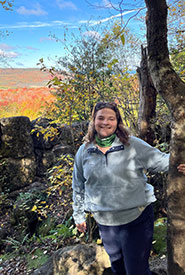The swamp’s unlikely hero: a beetle
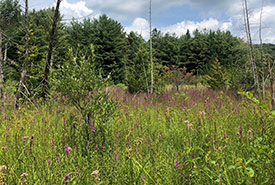
Purple loosestrife at Beaver Meadow wetland, ON. (Photo by Jen Arbeider/NCC staff)
When I first started as a conservation technician with the Nature Conservancy of Canada (NCC) in May, I was very excited to observe unique species of plants and wildlife, as well as work in a diversity of habitats and make a difference in conservation. However, I was not aware of all the cool projects I would get to be a part of during my internship.
With my internship being based in Central Ontario – West, which contains a diversity of wetlands, I knew that purple loosestrife would be one of the invasive wetland species on my radar. Purple loosestrife negatively impacts biodiversity by reducing nutrients and space for native plants, and degrades wetland habitat for fish, birds, insects and other wildlife. Unfortunately, it’s broad root system makes it extremely difficult for mechanical removal techniques like hand pulling, which was previously the form of invasive control done by staff and volunteers at the East Coulson Swamp property. Since 2016, staff and volunteers have attempted to mechanically remove these invasive plants from the East Coulson Swamp by hand pulling and removing several garbage bags full of plant material every year. However, their broad root system made it extremely difficult and time consuming to control using this technique, and the population continued to spread.
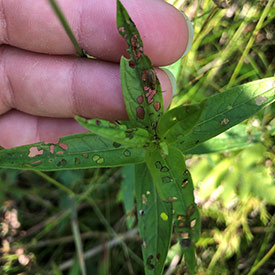
Adult beetle with evidence of feeding on purple loosestrife leaves. (Photo by Jen Arbeider/NCC staff)
Like all invasive species, it was not going to be easy to remove purple loosestrife from the wetlands…that is until the release of an insect known as European leaf-eating beetle. These beetles are known predators of purple loosestrife, as they prevent plant growth and reproduction by eating its buds and leaves – the use of living organisms to control populations of invasive species is known as biological control or simply biocontrol. Additionally, these beetles are only known to feed on invasive purple loosestrife and pose no threat to native plants. Since 1992, biocontrol initiatives involving releasing these beetles have been put into place across Ontario to manage purple loosestrife, with up to 90 per cent success. Last year, NCC began biocontrol treatment with the release of the beetles at two wetlands in the East Coulson Swamp. This year, we began the monitoring program to measure the abundance of purple loosestrife and the effectiveness of the beetles after their first year. I was excited for monitoring, as my field supervisor encouraged me to take the lead on this project by adapting an established protocol to meet our needs, building PVC pipe frames to create standardized monitoring plots and marking those plots in the field.
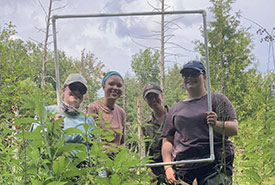
2023 Central Ontario - West technician team at East Coulson Swamp, ON (Photo by NCC)
In August, we put on our best pairs of hip waders and went out with cameras and measuring tapes to monitor the sites. We were excited to see larvae and adult beetle activity on the purple loosestrife leaves, which signalled that the beetles successfully overwintered and were feeding in their first year! We collected data and photos that would help us better understand and compare the impact of the beetles on the purple loosestrife population for each wetland in the future. To do this, we counted the number of purple loosestrife stems, seedling abundance, length of flower heads and beetle-feeding evidence for each square-metre plot. This was completed for all 12 plots across the two wetlands, and as you can imagine it took quite a bit of time to measure each flower head to the nearest millimetre!
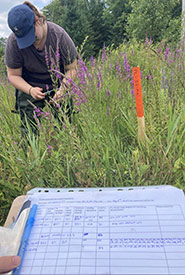
Purple loosestrife data collection. (Photo by Amanda Henderson/NCC staff)
Although these sites are being heavily impacted by the purple loosestrife invasion, there was evidence all around that the native plant community could recover. The East Coulson Swamp wetlands are important for many wildlife, as evidenced by the painted turtles that enjoy basking on logs and cedar waxwings perched on high branches around the wetlands, waiting to catch insects that fly above the water. I can only imagine the diversity of plants and wildlife species that will be able to enjoy these wetlands in years to come when native plants can grow free from invasives with the help of these beetles and our stewardship team.
A special thank you to 407 ETR for supporting the Conservation Intern Program in Ontario.

